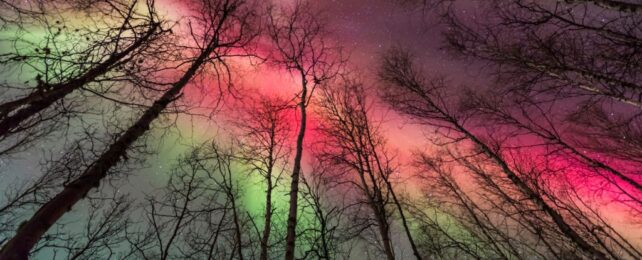On September 24, a strong storm of solar plasma struck Earth's magnetic field and set the night sky on 'fire'.
Across the northern hemisphere, from Europe to North America, those with clear skies were able to witness a spectacular red light show, described by at least one skywatcher as the 'Holy Grail of Northern Lights'.
Earth experienced a coronal mass ejection (CME) impact late yesterday (September 24, 2023). It was a strong (G3) storm and many in Europe and northernmost North America were surprised with the sight of a rare red aurora! Read more at: https://t.co/gNEIyUWJpK
— EarthSky (@earthskyscience) September 25, 2023
📸 Miguel Caballero pic.twitter.com/LGbsNCoknz
Red auroras are rare enough as it is, but to see them as far south as France and Kansas with the naked eye is quite remarkable.
Centuries ago, some people in these lower latitudes thought the scarlet skies were a sinister sign of future war or tragedy.
Today, scientists know that auroras, both green and red, are a natural occurrence that cause no real harm to humans, although that doesn't make them any less awe-inspiring.
#Aurora from Penryn Cornwall!! About as far south as you can get in the UK and still visible#Cornwall #Auroraborealis pic.twitter.com/1sXlqRfRjR
— Christopher Probert (@tophe_probert) September 24, 2023
The beautiful phenomenon is caused by an ejection of charged particles from the Sun, which interact with molecules of oxygen in Earth's atmosphere, thereby emitting light.
Depending on where in the atmosphere the charged solar particles collide with oxygen, the color of the resulting light is different.
The red #aurora appeared quickly before the #northernlights dispersed in the sky! September 18, 2023
— Rj Roldan (@rjayroldan) September 18, 2023
12:04 AM CT
South Indian Lake, MB #AuroraBorealis #spaceweather #CME pic.twitter.com/8qqvP0DY95
Green curtains are the most common aurora, caused by the emission of light by individual oxygen atoms floating high up in the atmosphere. Where showers of high-speed electrons have enough energy to push deeper into the atmosphere, they can force the more abundant nitrogen atoms and ions into emitting blues and pinks, which mix to form a soft purple at the curtain's fringe.
Deep red streaks of light, on the other hand, are caused by diffuse oxygen atoms at extremely high altitudes of around 200 to 300 kilometers (124 to 186 miles). Typically seen only during particularly energetic solar storms, the thin gas can hold onto the energy it absorbs for longer periods before emitting longer wavelengths.
#Aurora #Auroraborealis #Northernlights #Polarlights #Polarlichter
— ☃️Darth thromBOOzyt📯 (@krasmanalderey) September 24, 2023
For a few minutes it suddenly exploded and even here at roughly 54N it looked like you're in the polar areas. All the movement was visible, all the colors, im freaking out 🤯🤯🤯🤯🤯 this was so awesome (ALT-txt) pic.twitter.com/Y0WHd5ZFGz
Even though experts predicted that a solar storm would hit on September 24, the impact was stronger than expected.
The flare that came from the Sun triggered a strong geomagnetic storm above Europe almost immediately, causing bright green and red lights to dance across the sky in Scotland, Iceland, and the Netherlands.
Last night, most of the west of the Netherlands was under cloud-cover, but thankfully for a moment the intens green band and deep red pillar's of the #Aurora #noorderlicht #poollicht became visible.@TamithaSkov @helgavanleur @StormchaserNL @BuienRadarNL @Weerplaza @SonyNederland pic.twitter.com/LcoF0c23Or
— Raymond Kamstra (@kamstra_raymond) September 25, 2023
Later, the light show traveled across the Atlantic Ocean to North America. People as far south as Kansas and Nebraska saw their skies glow an eerie red, although the effect was not nearly as impressive as further north.
The weaker the aurora, the more hazy its glow of color; whereas the stronger it is, the more that the light breaks into bands, arcing across the night sky.
A few shots from last nights awesome aurora display from lossiemouth 🏴 she lit up the moray firth sky with red to the naked eye!! 👁🤯 #Aurora @TamithaSkov @AmazingAurora21 @BBCWthrWatchers @aurorawatchuk @_SpaceWeather_ @AuroraAlertsApp @SkyeAuroras @astro_apps_uk @TweetAurora pic.twitter.com/ZumbEdL6a3
— stevo howells (@Stevo_SnakeDR) September 25, 2023
This year has been a particularly fun one for aurora chasers. The last red aurora that graced the skies of North America and Europe came just a few months ago in February, and already this September, there have been several incredible northern light displays, that have also reached locations unusually far south.
The stream of recent eruptions from the Sun – due to a surprisingly energetic solar cycle – has included one strong enough to trigger radio blackouts in the US in June.
The normal cycle of solar activity goes for about 11 years, and at the moment, we are heading toward the peak.
Earth experienced a coronal mass ejection (CME) impact late yesterday (September 24, 2023). It was a strong (G3) storm and many in Europe and northernmost North America were surprised with the sight of a rare red aurora! Read more at: https://t.co/gNEIyUWJpK
— EarthSky (@earthskyscience) September 25, 2023
📸 Miguel Caballero pic.twitter.com/LGbsNCoknz
It's nothing to worry about – just a natural part of living on our planet – but it sure does make for some incredible nights.
"Sun activity is back to low, but we saw filament eruptions all over the solar disk, particularly in the northeast and northwest," wrote experts at EarthSky on September 26.
"These filaments hurled ejecta into space, and we await the results of specialist analysis to determine if a component of those blasts is coming our way."
Aurora chasers stay tuned.
